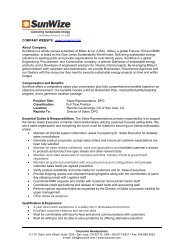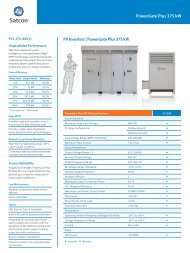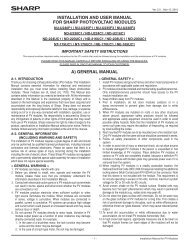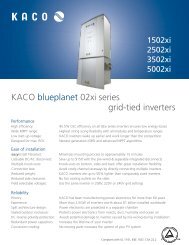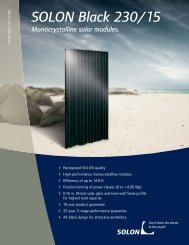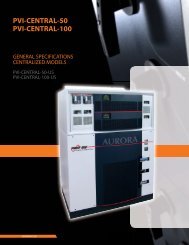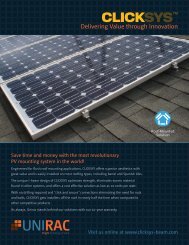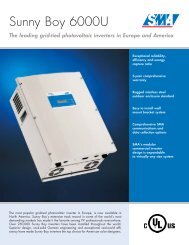The Sealed Battery Specialists - SunWize Technologies, Inc.
The Sealed Battery Specialists - SunWize Technologies, Inc.
The Sealed Battery Specialists - SunWize Technologies, Inc.
You also want an ePaper? Increase the reach of your titles
YUMPU automatically turns print PDFs into web optimized ePapers that Google loves.
<strong>The</strong> <strong>Sealed</strong> <strong>Battery</strong> <strong>Specialists</strong>© Copyright 2007 MK <strong>Battery</strong>
®MK <strong>Battery</strong>Certificate of Completionis hereby granted to:John Doefor attending, participating and successfully completing:NABCEP Registered training for:<strong>Battery</strong> 101 and <strong>Battery</strong> MaintenanceLength of class: 1 HourGranted: February 10, 2011Instructor – Doug Laningham
Worlds Largest single site Lead- Acid<strong>Battery</strong> Manufacturer - 600+ acresEast PennManufacturingLyon Station Pa.PittsburgAllentownReadingPhiladelphia3
World’s Largest and Most Modern Single-Site <strong>Battery</strong>Manufacturing Facility located near Reading, PAOver 2 million+ Square Ft and more than 600 AcresPresently>6000+ Employees4
MK <strong>Battery</strong> HistoryMK <strong>Battery</strong> – focused on niche markets utilizing primarilysealed batteries. Acquired by East Penn ManufacturingCompany, <strong>Inc</strong>. in 19955
MK <strong>Battery</strong> – <strong>The</strong> CompanyMK <strong>Battery</strong> is a sealedbattery specialist supplyingand distributing qualityproducts throughout NorthAmerica, Europe and AsiaPacific.Have customer distributiongloballyHave product deployed onall 7 continents.6
20 Distribution Centers7
<strong>SunWize</strong> – Dealer TrainingSolar <strong>Battery</strong> Training© Copyright 2007 MK <strong>Battery</strong>
<strong>Battery</strong> 101Chemistry of how a lead acid battery worksConstruction© Copyright 2007 MK <strong>Battery</strong>
How a <strong>Battery</strong> WorksCharged Cell:llFullyCharged:» POS = PbO 2» NEG = Pb» Electrolyte = 2H 2 SO 4– SpG (SpecificGravity)=1.265 to1.275+Two unlikemetals in sulfuricacid...PbO 2++H2SO4Pb© Copyright 2007 MK <strong>Battery</strong>
How a <strong>Battery</strong> Works(Continued)Discharged CelllFullyDischarged:» POS = PbSO 4» NEG = PbSO 4» Electrolyte = H 2 O» SpG ~ 1,150PbSO 4H2OPbSO 4lTwo like metals inwater...++© Copyright 2007 MK <strong>Battery</strong>
Discharging a Cell:Current flows (chemical reaction):Sulfate (SO 4 ) from acid (H 2 SO 4 ):combines w/Pb on both plates to formPbSO 4 (Lead Sulfate)Oxygen from POS combinesw/Hydrogen from acid to make H 2 OSpG moves closer to water (1.000)Result: Two like plates in water© Copyright 2007 MK <strong>Battery</strong>
Charging a Cell:Sulfate on surface of both plates (PbSO 4 ) splitinto Pb and SO 4Water (H 2 O) split into H & OAs Sulfate (SO 4 ) leaves plate surface:It combines w/Hydrogento restore Sulfuric Acid (H 2 SO 4 )SpG increasesOxygen combines w/Pb (+) to form LeadDioxide (PbO 2 )© Copyright 2007 MK <strong>Battery</strong>
Charged vs. DischargedTwo Unlike metals in acid:PbO 2H 2SO4PbTwo like metals in water:PbSO 4H 2OPbSO 4++++© Copyright 2007 MK <strong>Battery</strong>
Lead Acid BatteriesFlooded: Wet - Not SLAAGM: Absorbed Glass Mat (SLA)GEL: Gelled Electrolyte (SLA)© Copyright 2007 MK <strong>Battery</strong>
<strong>Battery</strong> ConstructionPlastic CaseLead Alloy Plates/GridsSeparatorsVents / ValvesSulfuric AcidLead StrapsLead Terminals© Copyright 2007 MK <strong>Battery</strong>
<strong>Battery</strong> Construction ……cont.Electrolyte is another term for <strong>Battery</strong> AcidPlates are also known as Lead GridsDifferent types of batteries have differentLead Alloys: Calcium,Calcium/Tin/Copper, Low Antimony, PureLead, Silver/Calcium© Copyright 2007 MK <strong>Battery</strong>
<strong>Battery</strong> ConstructionFlooded, (WET)– Calcium Alloys– Grids designed for Cycle Life– High density active materials to enhance cyclecapabilities– Thick separators© Copyright 2007 MK <strong>Battery</strong>
<strong>Battery</strong> Construction Absorbed Glass Mat, (AGM)– Calcium Alloys– Grids designed for Cycle Life– Absorbed Glass Mat Separators– Trapped Electrolyte - Contaminant Free– Safety Venting System - Valve Regulated© Copyright 2007 MK <strong>Battery</strong>
<strong>Battery</strong> Construction Gelled Electrolyte, (GEL)– Calcium Copper Alloys– Grids designed for Cycle Life– Glass Mat Backed Separators– Electrolyte “Vaseline-like”– Safety Venting System - Valve Regulated© Copyright 2007 MK <strong>Battery</strong>
Plastic CaseForged TerminalWeld GasketProtective CapSeparatorValveLead StrapLead GridEnvelopeSeparator
ManufacturingValvesGridsPastingPlate formation© Copyright 2007 MK <strong>Battery</strong>
Pressurized Sealing ValvesSingle most critical element of an SVR <strong>Battery</strong>Allows Hydrogen to escapeBurps briefly when X% pressure is developed inside the batterydue to excessive heat or overchargingCritical that it opens and closes properly to prevent dry outEssential for recombining of oxygen and hydrogen toproduce water which replaces the moisture in the battery,which means the battery never needs water, and thus ismaintenance freeNever open or attempt to open or remove thepressurized sealing valves/vents© Copyright 2007 MK <strong>Battery</strong>
ValveValve must remain reliable and functionalthroughout the life of the batteryValve must not allow air (O 2 ) into the batteryValves must open and reseal in the specified rangeGEL - Low pressure valve• Opening pressure = 0.9 - 2.5 psi• Closing pressure = 0.4 - 2.2 psi© Copyright 2007 MK <strong>Battery</strong>
Plates/GridsEach manufacturer designs the plates with differentthickness, size, grid patterns and alloysThickness is usually equated to cycle life as well as longevity beforebreak downPlate size is tied to AH of batteryGrid patterns allow for the speed of electron flow out of the battery.No need for high current flow in CATV applications.Alloys give the battery different characteristics, such as longevity,cycle life, float life, corrosion protection, applications, andconductance.Different types of batteries have different Lead Alloys:Calcium, Calcium/Tin/Copper, Pure Lead, Silver/Calcium,Low Antimony© Copyright 2007 MK <strong>Battery</strong>
Deep Cycle vs. Starting GridSLI – Thin grid –high current – short durationDeep Cycle – Thick grid –low current – long duration© Copyright 2007 MK <strong>Battery</strong>
<strong>Battery</strong> 101<strong>Battery</strong> types<strong>Battery</strong> facts
<strong>Battery</strong> TypesSLI: Starting, Lighting & IgnitionSLA: <strong>Sealed</strong> Lead AcidGelled Electrolyte (GEL)Absorbed (Starved) Electrolyte (AGM)VRLA – Valve Regulated Lead AcidSVR: <strong>Sealed</strong> Valve Regulated (SLA)What is a maintenance free battery?© Copyright 2007 MK <strong>Battery</strong>
<strong>Battery</strong> FactsMonoblocSingle case, multiple cellsMost common - 6 and 12 voltSingle cellHigh capacity2 voltWET, AGM, and GEL
<strong>Battery</strong> Facts12 Volt <strong>Battery</strong> has six cellsEach cell is 2.13 Volts2.13 x 6 = 12.78 Volts12.78 V or higher = Full ChargeDischarged <strong>Battery</strong> = 1.75 Volts per cell1.75 x 6 = 10.5 Volts (Low Voltage Cutoff)
<strong>Battery</strong> Facts - ContinuedWhat is an Amp Hour (AH)It is the amount of current (amps) that abattery can produce for one hour/hours ata specific discharge rateExample - 8G4DLTP (77F or 25C)– 210 AH @ C100 (100 hour rate)– 210 / 100 = 2.1 amps for 100 hours– 183 AH @ C20 (20 hour rate)– 183 / 20 = 9.15 amps for 20 hours
<strong>Battery</strong> 101ApplicationsPros and ConsBatteries in:SeriesParallelSeries Parallel© Copyright 2007 MK <strong>Battery</strong>
Pros and Cons - FloodedPros– Cycle life– Accepts higher recharge voltages and temperatures– Lower initial cost– Tolerant of overcharging– Less weight/Ah© Copyright 2007 MK <strong>Battery</strong>
Pros and Cons - FloodedCons:– Cycle life*– Acid can spill if battery is ruptured oroverturned– Acid can stratify– Less tolerant of low temperature– Gassing can cause corrosion of wiring, etc.*Can be the best cyclic battery or the fastest failing battery – dependent uponproper maintenance© Copyright 2007 MK <strong>Battery</strong>
Pros and Cons - AGM Pros– No maintenance required– Batteries can not spill if ruptured oroverturned– Batteries can be shipped UPS– Minimal gassing– Long cycle life– Low Temperature tolerant© Copyright 2007 MK <strong>Battery</strong>
Pros and Cons - AGM Cons– Higher initial cost– More weight– Less capacity– Less tolerant of overcharge– Less tolerant of high temperature© Copyright 2007 MK <strong>Battery</strong>
Pros and Cons - Gel Pros– No maintenance required– Batteries can not spill if ruptured oroverturned– Batteries can be shipped UPS– Minimal gassing– Superior cycle life– Low temperature tolerant– High temperature tolerant© Copyright 2007 MK <strong>Battery</strong>
Pros and Cons - Gel Cons– Higher initial cost– More weight– Slightly lower capacity© Copyright 2007 MK <strong>Battery</strong>
Batteries in SeriesVoltage adds up with each battery24 volt system – two 12 volt batteriesNegative to PositiveCurrent remains the same24 volt system – two 12 volt 100 AHbatteries in seriesRemains a 100 AH system
Batteries in Series12 voltOne 12 volt batteryTwo 6 volt batteries in series24 voltTwo 12 volt batteries in seriesFour 6 volt batteries in series48 voltFour 12 volt batteries in seriesEight 6 volt batteries in series
Batteries in Series – cont.Example - 24 volt system+ - +--12 V12 V++ - - + --+-6 V 6 V 6 V 6 V
Batteries in ParallelVoltage remains the sameFour 12 volt batteries in parallel = 12 voltsCurrent (AH) adds up with each batteryFour 12 volt 100 AH batteries in parallelequals 12 volts – 400 AH battery system
Batteries in ParallelExample - Four - 12 volt 100 AH batteries= 12 volts - 400 AH systemPosNeg+ - + -+ -+-12 V 12 V 12 V 12 V
Series Parallel StringsVoltage adds up with the number ofbatteries in series in a single stringCurrent (AH) adds with the number ofseries strings in parallelExample – 200 AH 48 volt systemTwo strings of four 12 volt 100 AHbatteries• 4 – 12 volt batteries in series = 48 volts• 2 strings of 4 100 AH batteries = 200 AH8 batteries total
Series Parallel - example48 volt – 200 AH systemNegPos++ - + - +--+-++ - - + --+-
Paralleling options<strong>The</strong> following two slides show fourparallel optionsWhich option is the best – why?How many strings are you allowed toconnect in parallel?
Paralleling Options++++++++++----OPTION - A24 Volt Inverter/Charger----OPTION B24 Volt Inverter/Charger++++++++----------47
++++++++++----OPTION C24 Volt Inverter/Charger----OPTION D24 Volt Inverter/Charger++++++++----------
<strong>Battery</strong> 101ChargingStorage6 factors affecting battery lifeDesign – Cycle lifeDesign – Depth of Discharge (DoD)Design – TemperatureDesign – Type of battery and proper sizingDesign – MaintenanceDesign – Proper charger/charging© Copyright 2007 MK <strong>Battery</strong>
StorageBatteries should be stored in a dry storage areaIdeal storage temperature is at 77 degrees F. (Or asclose to it as possible)Store batteries on lower shelves in warehouses• Cooler temperatures• Keep excessive weight low to the ground for safetyEvery 10 degrees over 77 F reduces the life of the batteryby halfShelf storage is three to six months maximum© Copyright 2007 MK <strong>Battery</strong>
Six factors effecting battery lifeAll tied to system designTemperature batteries are subject to long termProper chargingNumber of cyclesDepth of discharge (DoD)System design – battery sizing, size of arrayLack of maintenance – Especially flooded© Copyright 2007 MK <strong>Battery</strong>
TemperatureSustained exposure to high heat reduces life of thebatteryHigh heat warps plates and causes corrosion inbatteryReduces the life of lead acid batteriesWarranties are written around temperatures becauseof the high failure rate caused by excessive exposureto high heatDesign system to install batteries if possible to a coolarea in home or outside of home© Copyright 2007 MK <strong>Battery</strong>
<strong>Battery</strong> ChargingProper chargingSet charge voltage to type of battery• WET, AGM, GELSet bulk charge parameters by time if possible,not voltage (95% capacity with bulk charge)Absorb charge to 120% of what you dischargedBe sure to use temperature compensation• Undercharge – Sulfate• Overcharge – Gas off electrolyte© Copyright 2007 MK <strong>Battery</strong>
EPM – Charging parametersBULK CHARGE STAGE GEL AGM FLOODEDMAX CURRENT MONOBLOC DESIGN 30% of C20 30% of C20 30% of C20MAX CURRENT SINGLE CELL DESIGN 20% of C6 20% of C6 20% of C6ABSORPTION (REGULATION) STAGECONSTANT VOLTAGE 2.35 – 2.40 vpc 2.30 – 2.35 vpc 2.40 – 2.45 vpcFLOAT CHARGECONSTANT VOLTAGE 2.25 – 2.30 vpc 2.25 – 2.30 vpc 2.30 – 2.35 vpcEQUALIZE CHARGECONSTANT CHARGE 2.40 – 2.45 vpc 2.35 – 2.40 vpc 2.50 – 2.55 vpcVOLTAGE LIMITS AT 25C (77F)
Charging parameters - exExample of setting up correct charger<strong>Battery</strong> bank – 16 – 8G30H GEL4 strings of 48G30H – 98 AH @ C20Bulk charge set at 30% of C2098 x 30% = 29.4 amps @ C2029.4 amps x 4 strings = 117.6 amps (max)117.6 max amperage to charge this battery bankAbsorption voltage is 2.35 – 2.40 vpc (range)2.40 vpc x 6 cells = 14.40 x 4 batteries = 57.60 dc voltsAbsorption time is set to a minimum of 3 hoursFloat Voltage is 2.25 – 2.30 vpc (range)2.30 vpc x 6 cells = 13.80 x 4 batteries = 55.20 dc volts55
<strong>Battery</strong> ChargingImproper <strong>Battery</strong> ChargingNumber one cause of battery failure• Overcharging• Undercharging – (Solar)• Over DischargingMost Batteries do not fail due to a batteryproblem!© Copyright 2007 MK <strong>Battery</strong>
<strong>Battery</strong> Charging… cont.Your batteries are a good indicator that you haveeither a good or a bad maintenance programFailing batteries should raise a red flag:• Charger not working properly• Temperature probe not working/connected• <strong>Battery</strong> breaker off• Faulty products• Improperly designed system© Copyright 2007 MK <strong>Battery</strong>
Why Overcharging is Bad:Water (H 2 O) split into H & ODriven out of cellReduces electrolyte level or dries out SVR cellPotentially explosiveInternal Heat <strong>Inc</strong>reases:Accelerates POS grid corrosionWarps platesOxidizes (rusts) and weakens POS grid and separator© Copyright 2007 MK <strong>Battery</strong>
If Overcharging is so bad...Why not Undercharge? Sulfate on both plates hardens:– to a point where it can not be driven back intoelectrolyte POS grid oxidizes in water:– Accelerates POS grid corrosion– Oxidizes (rusts) and weakens POS grid Hydration– 1.050 SpG = solubility of Pb in Sep.. pores– recharging = re-crystallization ofPb = Shorts© Copyright 2007 MK <strong>Battery</strong>
Over-Discharging<strong>Battery</strong> starts to break down and is in a vulnerablestate when it is over-discharged<strong>Sealed</strong> <strong>Battery</strong> has visible characteristics<strong>Battery</strong> creates a vacuumTop and sides will often have ripples in themStarts when battery is discharged below 10.5 voltsHow can this happen?Low voltage cut off not workingParasitic loadsOvercharge/Undercharge© Copyright 2007 MK <strong>Battery</strong>
Over DischargingParasitic LoadsAny DC externally wired loadAny DC load powered after LVD shuts off© Copyright 2007 MK <strong>Battery</strong>
SulfationWhat causes sulfation:Over cycledUnderchargingOver dischargedLeaving battery in a discharge state over timeSymptoms – Hard Sulfation – Irreversible SulfationHigh Electrical resistanceWill not accept a chargeCan show a false voltage charge – often too high62
Sulfation - ContinuedFactors to reduce sulfationFully recharge after each dischargeRecharge immediately after dischargeUse proper voltage settingsIn cyclic applications – try reducing DoD to50% or less63
Spent BatteriesPositive Plate CorrodesPlates GrowPlate corrosionPlate sheddingExpand sometimes to far and cause cell toshort64
Spent Batteries – ContinuedWhat causes batteries to be spent:High TemperatureOvercyclingUsing wrong battery for wrong application• Deep cycle vs. starting• AGM vs. GELSymptoms:Reduced run timeHigh Electrical resistanceWon’t hold a chargeLow voltage readings65
Spent Batteries - ContinuedFactors to increase battery lifeLimit temperature to 27 degrees CFully recharge after each dischargeUse proper voltage settingsRecharge immediately after dischargeCyclic applications reduce DoD to 50% orless66
Number of cyclesWhat is a battery cycle?A battery cycle is equal to one discharge and onerechargeDoes not have to be equal amounts and can be anyamount of current out and current inOnce you have charged a battery all that you can thenthen start discharging again, that equates to one cycle<strong>The</strong> more you cycle a battery, the less life you getout of the battery67
Number of cyclesDiscussion with your customer??Three platforms of batteries – 5, 10, and 20 year designsHow long do you expect to get out of your batteries – iehow many years??After they tell you how long they want the batteries to last –review the data sheets for the type of battery they want andshow the DoD charts and what DoD their system will haveto be designed at to get the life they want.<strong>The</strong>n walk them through an exercise of sizing their system –taking their load - inserting the proper DoD, days ofautonomy, then factoring in efficiency of inverter/systemand then temperature and show them the reality of the sizeof the battery bank they need to get the cycle life theywant.68
<strong>Sealed</strong> <strong>Battery</strong> Cycle LifeComparison - Gel vs. AGMCapacity Life CyclesWithdrawn Gel AGM100% 450 15080% 600 20050% 1000 37025% 2100 92510% 5700 3100© Copyright 2007 MK <strong>Battery</strong>
Depth of Discharge (DoD)Depth of discharge is a function of designDeeper the discharge the shorter the life of thebatteryGEL <strong>Battery</strong> – example80% DoD – approximately 600 cycles10% DoD – nearly 6000 cyclesSolutionDesign for shallow discharges – especially sealed batteriesResult will be larger batteries or additional batteries© Copyright 2007 MK <strong>Battery</strong>
Why DoD is so critical48 volt – 360 AH @ C20 @ 50% DoD (Two strings of four of8G4DLTP – 180 Ah @ C20)NegPos++ - + - +--+-++ - - + --+-
Why DoD is so critical48 volt – 360 AH @ C20Discharge 50%NegPos+ - + -+ -+ -+ -+ -+ -+ -
Why DoD is so critical48 volt – 360 AH @ C20Recharged for 5 sun hours to full charge – 100% capacityNegPos++ - + - +--+-++ - - + --+-
Example of DoDNote: No Low Voltage Disconnect)End of Day one – discharge 50% at nightBatteries at 50% capacity – beginning of Day 2NegPos+ - + -+ -+ -+ -+ -+ -+ -
Example of DoDBatteries at 50% capacity – beginning of Day 2 (Cloudy Day)Charge only about 20% capacity due to cloudy day. Batteries nowat 70% capacityNegPos+ - + -+ -+ -+ -+ -+ -+ -
Example of DoDEnd of Day two – discharge 50% DoD second night = 70% capacity –50% discharge = 20% capacity for beginning of Day 3NegPos+ - + -+ -+ -+ -+ -+ -+ -
Example of DoDBatteries at 20% capacity – beginning of Day 3 (Cloudy Day)Charge only about 20% capacity due to cloudy day. Batteries now at40% capacityNegPos+ - + -+ -+ -+ -+ -+ -+ -
Why DoD is so criticalEnd of Day three – discharge load was to be 50% - Batteries nowdischarged 100%NegPos+ - + -+ -+ -+ -+ -+ -+ -
Why DoD is so criticalBeginning of Day four – Sunny Day - Recharge for 5 full sun hours – 50%capacityNegPos++ - + - +--+-++ - - + --+-
Why DoD is so criticalEnd of Day four – discharge load 50% - Batteries now discharged100%NegPos+ - + -+ -+ -+ -+ -+ -+ -
DoD RecapBatteries in example, are now in a cycling deficitBeing cycled everyday from an undercharged stateIf batteries do not get fully charged in a given period of time –batteries will failBatteries will begin to sulfateEventually the batteries will not accept a chargeIf batteries cannot be fully charged with PV system, youwill need to use a generatorBatteries need to be fully charged at least once a week ifpossible81
How do I set DoD on my inverteror charger??You cannot program an inverter or charger to a specificDoD.You also cannot identify what voltage is exactly aspecific DoD.You have to rely on sizing your system correctly …..DoD is determined by Amp Hours out – which is the loadRecharge time is based on Amp Hours out = Amp Hours in x120%.If you size a system and then decide you need a larger batterybank for a reduced DoD, you will have to increase your PVarray or generator size.82
Improper DesignBatteries are over cycledWill not hold a chargeBatteries are spentTypically not a large enough battery/bankSystem undersizedBatteries sulfateBatteries will not hold a chargeBatteries are not getting fully chargedTypically not a large enough solar array / wind generator© Copyright 2007 MK <strong>Battery</strong>
System SizingExercise – Spread sheet calculationsKnow what battery type when sizingLargest capacity – minimize parallel stringsChargingParallel strings – methods, issuesCharger/Inverter needs to be set up for type of battery andabsorption timeGenerator needs to be set up for proper charge voltage andabsorption timeREMEMBER – A WATT IS A WATT IS A WATT!!!
Temperature Compensation – 24 vdcTempChargeChargeFloatFloatChargeChargeTempF12v Opt.12v Max12v Min12v Max24v Opt24v MaxC≥ 120 13.00 13.30 12.80 13.00 26.00 26.60 ≥ 49110 – 119 13.20 13.50 12.90 13.20 26.40 27.00 44 - 48100 - 109 13.30 13.60 13.00 13.30 26.60 27.20 38 – 4390 – 99 13.40 13.70 13.10 13.40 26.80 27.40 32 – 3780 – 89 13.50 13.80 13.20 13.50 27.00 27.60 27 – 3170 – 79 13.70 14.00 13.40 13.70 27.40 28.00 21 – 2660 – 69 13.85 14.15 13.55 13.85 27.70 28.30 16 – 2050 – 59 14.00 14.30 13.70 14.00 28.00 28.60 10 – 1540 – 49 14.20 14.50 13.90 14.20 28.40 29.00 5 – 9≤ 39 14.50 14.80 14.20 14.50 29.00 29.60 ≤ 4Charging rates shown are for Gel batteries© Copyright 2007 MK <strong>Battery</strong>
Temperature Compensation – 48 vdcTempChargeChargeFloatFloatChargeChargeTempF12v Opt.12v Max12v Opt.12v Max48v Opt48v MaxC≥ 120 13.00 13.30 12.80 13.00 52.00 53.20 ≥ 49110 – 119 13.20 13.50 12.90 13.20 52.80 54.00 44 - 48100 - 109 13.30 13.60 13.00 13.30 53.20 54.40 38 – 4390 – 99 13.40 13.70 13.10 13.40 53.60 54.80 32 – 3780 – 89 13.50 13.80 13.20 13.50 54.00 55.20 27 – 3170 – 79 13.70 14.00 13.40 13.70 54.80 56.00 21 – 2660 – 69 13.85 14.15 13.55 13.85 55.40 56.60 16 – 2050 – 59 14.00 14.30 13.70 14.00 56.00 57.20 10 – 1540 – 49 14.20 14.50 13.90 14.20 56.80 58.00 5 – 9≤ 39 14.50 14.80 14.20 14.50 58.00 59.20 ≤ 4Charging rates shown are for Gel batteries© Copyright 2007 MK <strong>Battery</strong>
THANK YOUFOR YOUR ATTENTION!© Copyright 2007 MK <strong>Battery</strong>
Sunwize Sales ManagersMeghan Bonenfant, NY mbonenfant@sunwize.com, NY (845) 336-0146 x7142Mark Brown, AZ mbrown@sunwize.com , AZ (866) 993-5636Charlie Bachman, CO, cbachman@sunwize.com, (303) 604-1125Helga Canfield, NV, hcanfield@sunwize.com, (800) 232-7652David Martindale, NY, dmartindale@sunwize.com, (866) 542-7972Steve Naccarato, NY, snaccarato@sunwize.com, (877) 857-6527Mark Paddison, Canada, mpaddison@sunwize.com, (800) 507-2585Mark Perry, CA, mperry@sunwize.com, (408) 510-5061Mona Rotkopf, NY, mrotkopf@sunwize.com, (800) 333-1245Wayne Robertson, CA, wrobertson@sunwize.com, (800) 344-2003Patrick Rogers, MT progers@sunwize.com, (406) 333-4290Mario Tantillo, NY mtantillo@sunwize.com (845) 336-0146 x7115Mike Troutner, FL mtroutner@sunwize.com, (877) 270-2241Lillian Vasconcellos, CA lvasconcellos@sunwize.com, (909) 758-4925Vicki Wallace, CA, vwallace@sunwize.com, (800) 344-2003Jim Westover, CA, jwestover@sunwize.com, (877) 400-5150Bruce Wilson, MD, bwilson@sunwize.com, (410) 480-7175Stephanie Winston, CA, swinston@sunwize.com, (909) 758-4921



